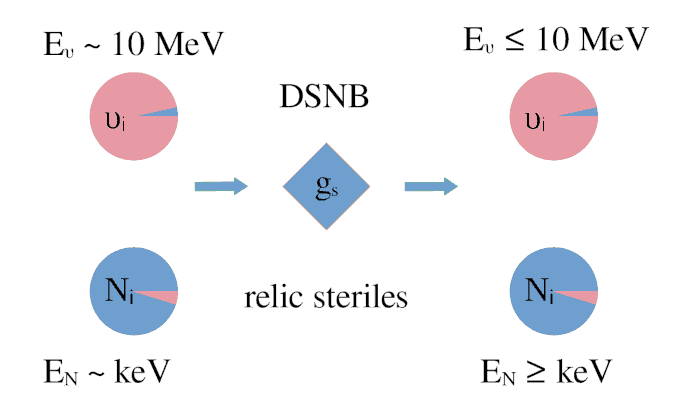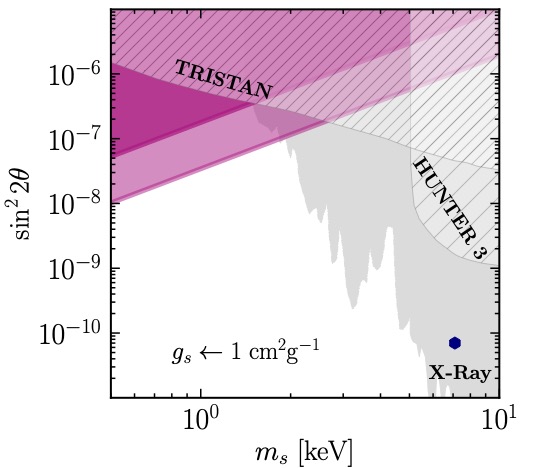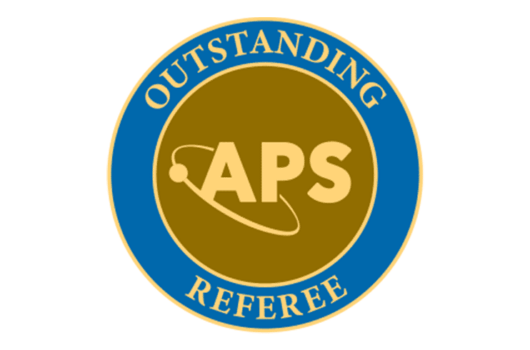Can diffuse supernova neutrino background detection reveal sterile neutrino secrets?
Prepared by Anna M. Suliga
The nature of neutrinos is yet to be understood. These elusive particles, thought to be undetectable and massless, now point to an existence of physics beyond the Standard Model. Searches for additional neutrino families, i.e., sterile neutrinos or new neutrino interactions, center on uncovering neutrino nature and are often motivated by solving a particular problem or anomaly. In our work, we showed how future detection of the diffuse supernova neutrino background (DSNB) could facilitate probes of the physics of a relic background of a keV-mass self-interacting sterile neutrinos.
The DSNB neutrinos travel cosmological distances, allowing them ample opportunity to interact with the sterile relics if a non-zero vacuum mixing between the active and sterile sector neutrinos exists. Even in the case of negligibly small mixing with the active neutrinos, the long baselines, high number density of sterile states, and strong self-coupling enable sterile neutrinos to encode the information about their existence in the active neutrino DSNB signal. The strongly self-coupling sterile neutrinos we suggest could be consistent with the required self-coupling for dark matter self-interactions invoked to explain an assortment of small-scale issues. These issues include, for example, the cusp-core problem for dwarf galaxies.

The cartoon (Figure 1) shows how the light mass eigenstate from DSNB (υi), which has a small admixture of the sterile flavor (blue color), can resonantly interact with the primarily sterile heavy mass eigenstate (Ni) from the relic sterile neutrino background. In such a scenario, the DSNB neutrino gets down scattered, leaving a characteristic dip in the spectrum at an energy dictated by the mass ratio of the heavy mass eigenstate and self-interaction mediator mass.
An exciting consequence of such strongly self-interacting sterile neutrinos could be a positive detection in terrestrial sterile neutrino experiments, such as TRISTAN, and a correlated dip signal in the DSNB spectrum. This would be an apparent signature of a strongly self-interacting sterile neutrino dark matter component. Such a result could also hint at a rich dark sector connected with neutrinos. Likewise, if the laboratory experiments find evidence of these sterile states, but no corresponding dip signature in the DSNB is detected, then we can constrain self- interaction and vacuum mixing parameters of the sterile neutrinos. That, in turn, could narrow the range of possibilities for dark matter sterile neutrino production mechanisms.

Figure 2. The 95% C.L. sensitivity limits on the mass ms, and the effective vacuum mixing angle with active species, θ of the self-interacting sterile neutrino dark matter. The mediator mass dictates the resonance energy ER in the DSNB observation window. We consider two cases where the indicated parameters give detectable dips: neutrino temperature emitted from supernovae Tν = 4 MeV and ER = 15 MeV (darker pink regions); and Tν = 8 MeV and ER = 20 MeV (lighter pink regions). The sterile neutrino self-coupling is set to the limit on the dark matter self-coupling cross section 1cm2 g-1. We also show the X-ray limits from radiative decay of dark matter (gray regions), future sensitivities of TRISTAN (densely hatched regions) and HUNTER 3 (sparsely hatched regions), and the 3.5 keV line sterile neutrino hint (blue octagons). The calculated sensitivities are stronger for smaller masses of the sterile neutrinos because they have a higher number density.
We calculated the sensitivity limits for the dips in the DSNB for a 3740 kton yr exposure in the Hyper-Kamiokande experiment (see Figure 2). Our sensitivity limits can probe sterile neutrino masses below 2 keV, which are not ruled out by the X-ray radiative decay constraints but can be probed by TRISTAN. However, this region of the sterile neutrino masses is restricted by the large-scale structure formation arguments if sterile neutrinos have thermal velocity distribution. However, a non-trivial velocity distribution may remain consistent with the Lyman-alpha forest structure bounds. In the case of a TRISTAN discovery and the presence of dips in the DSNB, such a sterile neutrino could point to a non-trivial neutrino dark sector.
Header image: A dwarf galaxy (Messier 101), viewed through the Hubble telescope. Credit: NASA Goddard
Read More:



